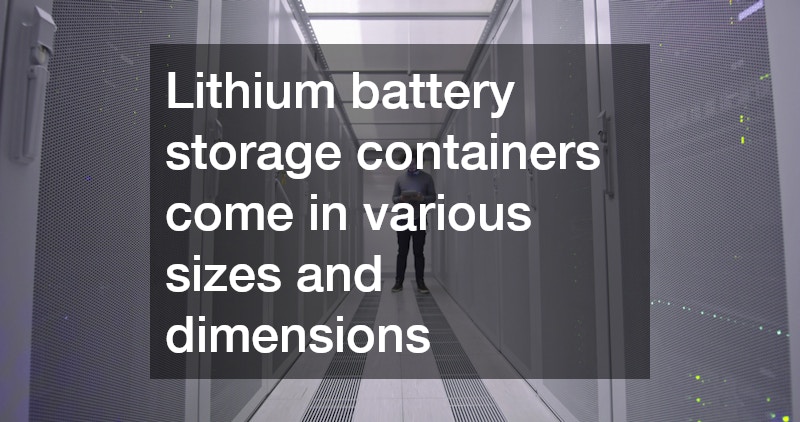
This article serves as a comprehensive guide on what to consider when selecting a lithium battery storage container. Understanding the necessary criteria will ensure safety, reliability, and efficiency in battery storage. The right storage container not only protects the batteries from physical and environmental hazards but also prolongs their life and performance.
Here, we break down the key considerations for selecting the best lithium battery storage container for your requirements.
How Safe Is the Lithium Battery Storage Container?
Fire Resistance and Thermal Management
A crucial feature of any lithium battery storage container is its ability to resist fire. Lithium batteries pose a risk of thermal runaway—a chain reaction of overheating that can lead to fire. Therefore, selecting a container built with fire-resistant materials is paramount. Such containers often incorporate advanced thermal management systems to dissipate heat and prevent overheating. Ensuring good thermal management not only safeguards batteries from catching fire but also enhances overall performance by maintaining an optimal temperature range.
Leak-Proof Design
Another essential aspect of safety in lithium battery storage is a leak-proof design. This feature prevents any hazardous leakage of battery fluids that could cause damage or pose safety risks. Containers with effective sealing mechanisms ensure that the stored batteries remain dry and free from external contaminants.
The storage container also needs to provide robust impact resistance. This ensures that the stored lithium batteries are protected from any physical impacts or accidental drops. Durable materials and reinforced designs are typical in high-quality containers to withstand rough handling and transportation. Shock absorption features like padded interiors can further cushion the batteries from jolts and vibrations. This is crucial for maintaining the structural integrity of the batteries and reducing the likelihood of internal damage.
What Is the Container’s Capacity and Size?
Understanding Your Storage Needs
Before selecting a lithium battery storage container, it’s crucial to assess your specific storage needs. Understanding the volume of batteries you need to store helps determine the appropriate capacity of the container. This involves taking stock of the types and sizes of batteries and their respective power capacities. Accurate assessment avoids overspending on needlessly large containers and ensures you don’t run out of space with a container that’s too small.
Available Sizes and Dimensions
Lithium battery storage containers come in various sizes and dimensions to suit different needs and spatial constraints. Options range from small, portable cases to large, industrial-grade units capable of housing significant battery arrays. Knowledge of available sizes assists in selecting a container that seamlessly integrates into your workspace or storage area. This consideration is particularly crucial for facilities that have limited floor space. Hence, choosing the right size and dimension is about balancing storage needs with available physical space.
Scalability Options
Scalability is an important consideration, particularly for businesses expecting growth or fluctuations in battery storage needs. Select containers that offer modular designs or options for expansion to accommodate changing demands. Scalability ensures that your storage solution remains viable as your inventory of lithium batteries increases over time. This can save significant cost and effort compared to purchasing new containers as storage needs change.
Is the Container Weatherproof?
Material Durability
One vital factor in assessing a lithium battery storage container is its material durability, particularly regarding weatherproofing. High-quality containers are constructed from materials that withstand extremes of temperature, UV exposure, and moisture. Examination of material types, such as corrosion-resistant metals or durable plastics, helps determine the container’s longevity. Investing in durable materials enhances the lifespan of the container while protecting the stored batteries from environmental damage. Longevity directly correlates with the cost efficiency and reliability of your storage solutions.
Resistance to Moisture and Humidity
A significant feature for any lithium battery storage container is its resistance to moisture and humidity. These containers must have sealing and protective features that guard against water ingress, whether from rain, floods, or high humidity. Moisture-resistant containers often use robust sealing systems and drainage features to manage and expel unwanted fluids. Maintaining a water-free environment helps preserve battery condition, as lithium batteries are sensitive to moisture, which can lead to corrosion or malfunction. Resistance to humidity and moisture ultimately ensures the effective protection and longevity of your stored batteries.
Temperature Fluctuation Control
Effective temperature fluctuation control is a vital feature when selecting a lithium battery storage container. Temperature swings can negatively impact battery life and performance, making consistent internal conditions crucial. Some containers include insulation or temperature-regulating technologies like built-in cooling systems to maintain optimal conditions. Understanding the thermal management capabilities of a container helps ensure that it can withstand and regulate fluctuations, thus prolonging battery life.
Choosing the right lithium battery storage container involves considering various factors such as safety, size, weatherproofing, accessibility, and cost. By evaluating these aspects, you can ensure that your storage solution meets your specific requirements effectively and efficiently. Each factor is crucial in selecting a container that not only safeguards your batteries but also integrates seamlessly into your operational landscape.


